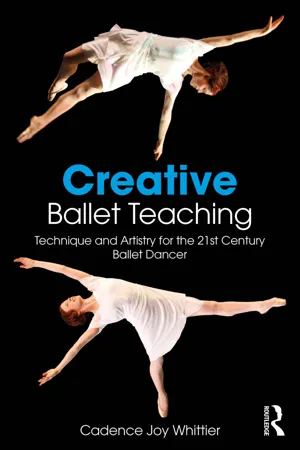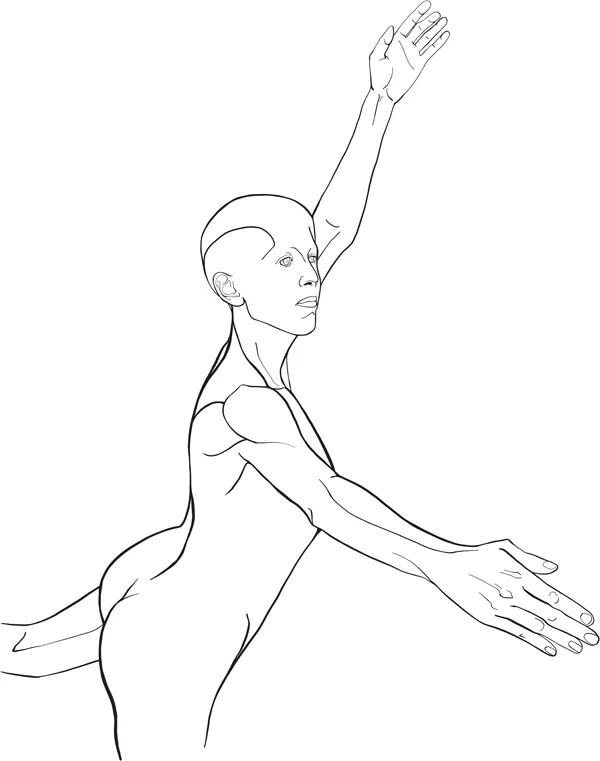
Creative Ballet Teaching
Technique and Artistry for the 21st Century Ballet Dancer
- 280 pages
- English
- ePUB (mobile friendly)
- Available on iOS & Android
About this book
How do teachers create a classroom environment that promotes collaborative and inquiry-based approaches to learning ballet? How do teachers impart the stylistic qualities of ballet while also supporting each dancer's artistic instincts and development of a personal style? How does ballet technique education develop the versatility and creativity needed in the contemporary dance environment?
Creative Ballet Teaching draws on the fields of Laban/Bartenieff Movement Analysis (L/BMA), dance pedagogy, and somatic education to explore these questions. Sample lesson plans, class exercises, movement explorations, and journal writing activities specifically designed for teachers bring these ideas into the studio and classroom. A complementary online manual, Creative Ballet Learning, provides students with tools for technical and artistic development, self-assessment, and reflection.
Offering a practical, exciting approach, Creative Ballet Teaching is a must-read for those teaching and learning ballet.
Frequently asked questions
- Essential is ideal for learners and professionals who enjoy exploring a wide range of subjects. Access the Essential Library with 800,000+ trusted titles and best-sellers across business, personal growth, and the humanities. Includes unlimited reading time and Standard Read Aloud voice.
- Complete: Perfect for advanced learners and researchers needing full, unrestricted access. Unlock 1.4M+ books across hundreds of subjects, including academic and specialized titles. The Complete Plan also includes advanced features like Premium Read Aloud and Research Assistant.
Please note we cannot support devices running on iOS 13 and Android 7 or earlier. Learn more about using the app.
Information
Part I
Rethinking creativity, community, and technique in the ballet classroom
Chapter 1
Drawing inspiration from creative movement
Teaching and planning from movement concepts

Teaching from movement concepts
Movement category | Movement concept | Skills explored |
|---|---|---|
BODY | Movements of the body | • Discover singular body parts and movements • Move body regions (right, left, upper, lower) |
Relationships | • Explore how parts of the body coordinate | |
Mobile and stable | • Practice locomotive movements through space • Learn about posture, balance, and stillness | |
SHAPE | Shapes | • Explore different body shapes (round, linear, twisted, flat, big, small) |
Forming | • Practice how shapes grow and shrink, open and close | |
SPACE | Spatial pathways | • Travel along curved, straight, zigzag, and meandering pathways |
Levels | • Move in different spatial levels: high, medium, low | |
Directions | • Move in different directions: up, down, right, left, forward, back | |
ENERGY | Time | • Perform movements at different speeds: fast, slow, medium, acceleration, and deceleration |
Weight | • Explore movements that are forceful or gentle, or limp and floppy | |
Flow | • Explore movements that are controlled or uncontrolled, smooth or choppy | |
MUSICALITY | Rhythm | • Explore the rhythms of different dance steps • Learn how to move to different rhythms and musical meters |
- 1 BODY—relationships: Ballet students explore the relationship between their feet and the floor, or between the supporting and gesturing sides of the body, or between the head and the arms. The students then identify how these relationships support their execution of different movements performed in class, such as battement tendu, sauté, pirouette, grand battement.3 What type of body relationships do you ask your students to explore in class?

- 2 SHAPE—forming: Ballet students explore how the balletic exercises follow rhythms of opening and closing in balletic steps and exercises. For example, my students often focus on the spreading and enclosing of the legs and arms in a port de bras, battement fondu developpé, or glissade. This helps them invest in the exercises and steps as movements instead of as static positions.4 How do you teach the kinetic quality of balletic steps in your classes?

- 3 SPACE—directions: Ballet students explore directional ballet vocabulary, such as, en arrière (backward), en avant (forward), en dedans (inward), en dehors (outward). They also explore the directionality of their torso and limbs in space: the forward and upward pull of the upper torso, head, and arm in first arabesque, the backward and downward reach of the leg in tendu derrière, or the side-to-side counter-pull of the supporting arm and gesturing leg in developpé à la seconde. Exploring directionality in class clarifies spatial intent and body alignment.5 How do you develop your students’ spatial awareness during technique class?

- 4 ENERGY—force: Ballet students explore how use of force changes the intensity of a step. For example, executi...
Table of contents
- Cover
- Title
- Copyright
- Dedication
- Contents
- List of Tables
- Acknowledgments
- Introduction
- Part I Rethinking creativity, community, and technique in the ballet classroom
- Part II Improving balance and motion
- Part III Deepening dynamism
- Glossary
- Bibliography
- Index